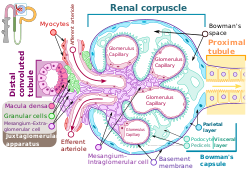User:Miajl101/Test
| This is not a Wikipedia article: It is an individual user's work-in-progress page, and may be incomplete and/or unreliable. For guidance on developing this draft, see Wikipedia:So you made a userspace draft. Find sources: Google (books · news · scholar · free images · WP refs) · FENS · JSTOR · TWL |
| Juxtaglomerular cell | |
|---|---|
 Microscopic image of juxtaglomerular cells | |
 Drawing of renal corpuscle showing juxtaglomerular cells (granular cells), Macula densa cells and extraglomerular mesangium. | |
| Anatomical terminology |
Introduction to Juxtaglomerular cells:
Juxtaglomerular cells are located in the kidneys. The kidney is a very important organ in our body that helps filtrate the blood in our body and passing waste out through urine. There are many sections in the kidney that makes up the structure such as; the renal cortex, renal medulla and renal pelvis. The renal cortex is located on the walls on the kidney under the adrenal gland. The renal medulla is located in the inside of the kidney under the renal cortex. The renal pelvis is located in the middle of the kidney. There is a part of the kidney called a nephron which regulates solid and water. In the Nephron is a structure called the Juxtaglomerular Apparatus, this structure is encharged of regulating blood pressure with the help of the cells located in the structure. In the Juxtaglomerular Apparatus the cells that are used are the extraglomerular mesangial cell, macula densa cell and juxtaglomerular cells. Throughout this article, Juxtaglomerular cell will be discussed thoroughly. This is the cell that produces and secrete renin in order to assist in controlling blood pressure.
Location of the Juxtaglomerular cells:
The Juxtaglomerular cell is located in a structure that job is to regulate the filtration of blood and blood pressure rate in the kidney called the Juxtaglomerular Apparatus. The distal convoluted tubule and the glomerular afferent arteriole forms the Juxtaglomeruler apparatus. The Juxtaglomerular apparatus is located in the nephron near the glomerulus structure. The cells in this structure help the Juxtaglomerular Apparatus function because of each cells job. The macula densa cell function is to regulate the concentration of sodium in the kidney. The extra glomerular mesangial cell job is to regulate systemic blood pressure. Additionally, this cell helps support the structure. The Juxtaglomerular cells job is to secrete renin so that that blood pressure can decrease.
Juxtaglomerular cells Function:
The juxtaglomerular cell function is to produce and secrete renin. Renin is an enzyme that is stored in the kidney that produces protein angiotensin. The juxtaglomerular cell is located near the afferent arteriole walls. The reason why the cells is located so close to the afferent walll is because the afferent arterioles are able to detect blood pressure drop. When the kidneys blood pressure drops the afferent arterioles deteectsthe rate on the blood pressure decreasing. Following this detection, the juxtaglomerular cell releases the renin. Finally, when renin is released from the cells it actively working to increase the rate of the blood pressure in the body.
Why Juxtaglomerular cell is impotent:
If the Juxtaglomerular Apparatus did not contain the Jutagloomerular cell our body would he affected tremendously. If the cells is not working properly the body would be at risk of the blood pressure being extremely high. High blood pressure has a negative impaction the body due to the affects. When an organism has high blood pressure it can cause a decrese in flexibility of the arteries. This occurs because because the excess of pressure causes the blood to clot. High blood pressure can lead you body to having a stroke, heart attack, heart failure and more due to the stress that the body is on to flow the blood in the body.
<ref>https://quizlet.com/136233941/juxtaglomerular-apparatus-flash-cards//ref> <ref>http://medcell.med.yale.edu/histology/urinary_system_lab/juxtaglomerular_apparatus.php/ref>
The juxtaglomerular cells (JG cells, or granular cells) are cells in the kidney that synthesize, store, and secrete the enzyme renin. They are specialized smooth muscle cells mainly in the walls of the afferent arterioles, and some in the efferent arterioles, that deliver blood to the glomerulus. In synthesizing renin, they play a critical role in the renin–angiotensin system and thus in autoregulation of the kidney.
Juxtaglomerular cells secrete renin response to a drop in pressure detected by stretch receptors in the vascular walls, or when stimulated by macula densa cells. Macula densa cells are located in the distal convoluted tubule, and stimulate juxtaglomerular cells to release renin when they detect a drop in sodium concentration in tubular fluid. Together, juxtaglomerular cells, extraglomerular mesangial cells and macula densa cells comprise the juxtaglomerular apparatus.
In appropriately stained tissue sections, juxtaglomerular cells are distinguished by their granulated cytoplasm.
The juxtaglomerular cell is a cell that is located near the glomerulus, hence its name.
Similar to cardiac tissue, juxtaglomerular cells harbor β1 adrenergic receptors. When stimulated by epinephrine or norepinephrine, these receptors induce the secretion of renin. These cells also respond directly to a decrease in systemic blood pressure which is manifested as a lower renal perfusion pressure.
See also[edit]
External links[edit]
- Histology image: 16010loa – Histology Learning System at Boston University

